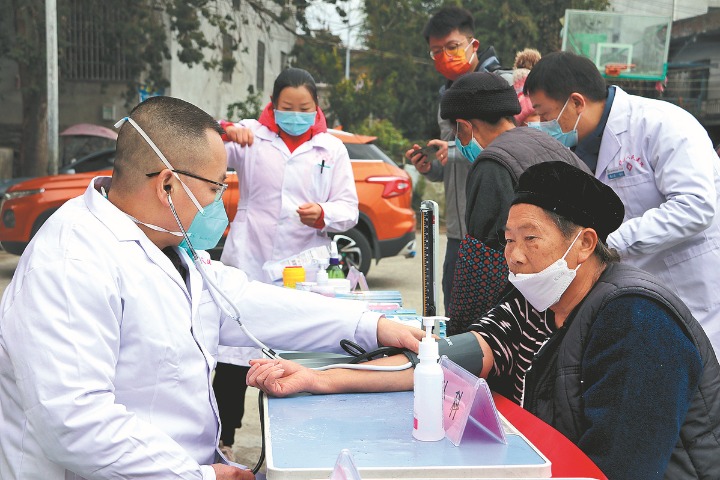How did China guarantee sufficient medical protective materials amid the outbreak?
It is important to note that the information provided in this Series is intended for your general knowledge only and is not a substitute for professional medical advice or treatment.

With the COVID-19 outbreak coinciding with the Lunar New Year, most Chinese companies were temporarily suspended for the holiday week. There was also limited storage in regular times. For such reasons, China encountered serious shortage of medical materials and equipment at the initial stage of the epidemic. In hard-hit areas like Wuhan, the tension between demand and supply for medical materials and equipment was especially concerning. In this context, the Chinese government took decisive measures to lead local governments, businesses and the society to work together to increase the supply of equipment and ensure smooth flow of these goods. Individuals and organizations at home and abroad also made generous donations to support the affected areas. Consequently, the shortage of protective materials in various regions across China was effectively addressed.
Increased Production Capacity
After the COVID-19 broke out, government agencies including the Chinese Ministry of Industry and Information Technology (hereinafter MIIT) responded with a series of policies pertaining to the production of medical equipment. These policies aimed to guide the protective equipment manufacturers to recover their production capacity and encourage other manufacturers to switch their production lines as needed. According to the data provided by MIIT, as of March 6, the daily production capacity of protective suits had increased from less than 20,000 to 500,000 and the daily production capacity for N95 masks had increased from 200,000 to 1.6 million, with an improved ability to produce 100 million regular facial masks per day. The production capacity for other medical protective materials and equipment was also significantly improved.
Optimized Allocation
Two approaches were adopted in the allocation of protective materials and equipment. First, nationwide mobilization and coordination was affirmed to secure the supply of protective equipment for worst-affected regions such as Wuhan and Hubei province in general. MIIT dispatched task forces to manufacturers of essential medical equipment and ensured same-day transportation of produced medical equipment to logistics companies for storage and shipping. They regularly coordinated and tracked the shipping process, making sure that the materials and equipment were timely delivered to Wuhan. Additionally, other provincial governments also worked diligently to mobilize and acquire essential supplies in support of Wuhan.
Second, protective materials and equipment were mobilized and allocated at the provincial level to balance inner-provincial demand and supply. Leading groups for epidemic control and prevention of each province gathered information about the need for emergency medical products and assigned corresponding tasks to local manufacturing and storage facilities. After the completion of production and purchase, the headquarters distributed the equipment according to varying degrees of emergency, securing the supply for the most-needed locations. Intercepting or appropriating essential supplies such as facial masks and disinfectant without authorization were clearly prohibited.
Streamlined Logistics
The Ministry of Transportation issued a guideline on January 24, waiving the toll of trans-provincial highway for all vehicles transporting emergency equipment for epidemic response and giving such vehicles priority. The National Development and Reform Commission organized over 100 logistics companies to establish a green channel for the protective materials and equipment for epidemic response, which provided express shipping service for such protective materials and equipment. As of February 7, SF Airlines had arranged multiple temporary domestic cargo flights to Wuhan, transporting over 800 tons of emergency materials and equipment including protective suits and surgical masks. Meanwhile, the green channel of Suning Logistics dispatched over 30 vehicles and shipped over 350 tons of materials and equipment.
Calling for Donation
During the epidemic, many countries, businesses, social organizations and individuals across the world donated a considerable amount of goods to the worst-affected regions in China. The statistics of the Wuhan Red Cross Society indicate that, as of March 13, Wuhan had received 19.74 million facial masks and respirators and 825,000 protective suits from home and abroad. The generous donation provided tremendous help in the fight against COVID-19.
References:
[1]http://www.chinanews.com/cj/2020/02-07/9082692.shtml
[2]http://www.myzaker.com/article/5e6e1ada8e9f097eee3d78f2
[3]http://www.cena.com.cn/industrynews/20200131/104456.html
[4]http://www.gov.cn/zhengce/zhengceku/2020-01/30/content_5473116.htm
[5]http://www.xinhuanet.com//info/2020-01/25/c_138733287.htm
Authors: Yu Lu (Center for International Knowledge on Development), Ma Jun (Center for International Knowledge on Development), Lin Weiwei (Institue of Medical Information, Chinese Academy of Medical Science)
Please feel free to contact us by sending your questions to question@chinadaily.com.cn or commenting on China Daily app. We will ask experts to answer them.














